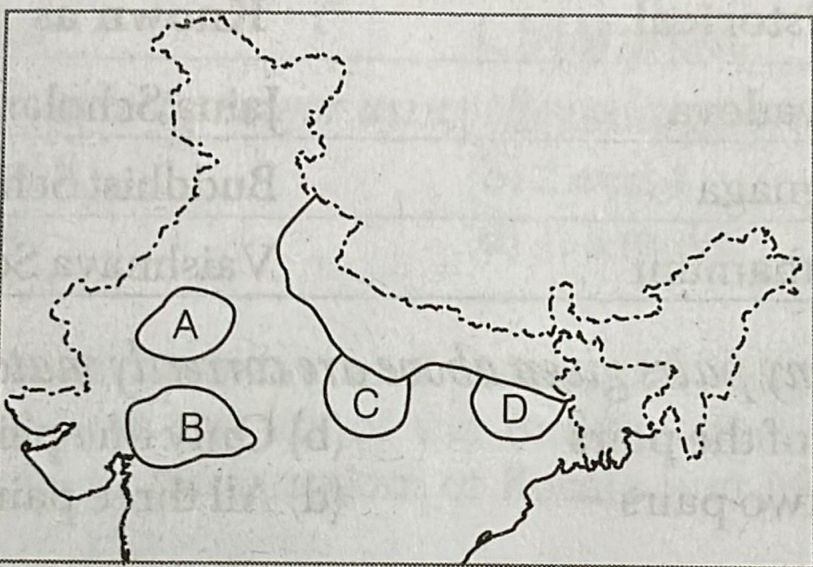In the UPSC Prelims examination, questions on Ancient History, particularly focused on the Mahajanapadas and Pre-Mauryan Age, often delve into the political, social, and economic dynamics of early Indian civilization. Candidates are frequently tested on their understanding of the emergence and significance of the Mahajanapadas, the sixteen powerful kingdoms that flourished before the Mauryan Empire’s rise. Topics may include the geographical spread of these kingdoms, their political structures, notable rulers, and their interactions with neighboring states. Moreover, questions may explore the economic and cultural aspects of this era, such as trade networks, urbanization, and religious developments, including the heterodoxies like Buddhism and Jainism. Candidates are expected to have a comprehensive grasp of these topics to effectively navigate the UPSC Prelims examination.
Contents
- 1 Q1. The following map show four of the sixteen mahajanapadas that existed in ancient India. (1997)
- 2 Q2. Which one of the following was initially the most powerful city/state of India in the 6th century BC? (1999)
- 3 FAQs
- 3.1 Q: What were Mahajanapadas in ancient India?
- 3.2 Q: What was the significance of the Mahajanapadas in ancient Indian history?
- 3.3 Q: Who were the major rulers of the Pre-Mauryan Age and what were their contributions?
- 3.4 Q: What were the economic features of the Mahajanapadas?
- 3.5 Q: How did the Mahajanapadas contribute to the growth of ancient Indian society and culture?
- 4 In case you still have your doubts, contact us on 9811333901.
Q1. The following map show four of the sixteen mahajanapadas that existed in ancient India. (1997)

The places marked A, B, C and D respectively are
(a) Matsya, Chedi, Kosala, Anga
(b) Surasena, Avanti, Vatsa, Magadha
(c) Matsya, Avanti, Vatsa, Anga
(d) Surasena, Chedi, Kosala, Magadha
Ans. (c)
Exp. – A, B, C, and D correspond to Matsya, Avanti, Vatsa, and Anga, respectively. Matsya Mahajanapada is located in what is now the Jaipur and Bharatpur-Alwar region of Rajasthan. Avanti corresponds to modern-day Ujjain in Madhya Pradesh. Vatsa Mahajanapada lies in the Gangetic Plain, presently known as Kosam in Uttar Pradesh. Anga is situated in modern-day Bhagalpur, Bihar. The Anguttaranikaya mentions all 16 Mahajanapadas.
Q2. Which one of the following was initially the most powerful city/state of India in the 6th century BC? (1999)
(a) Gandhar
(b) Kamboj
(c) Kashi
(d) Magadha
Ans. (d)
Exp. – During the 6th century BC, Magadha stood as the preeminent city-state in India, boasting unrivaled power. This dominance persisted from the 6th to the 8th century BC, as Magadha evolved into the focal point of numerous expansive kingdoms and empires. This supremacy endured through successive dynasties, notably under the Nanda in the 4th century BC and later, the Mauryan rule.
FAQs
Q: What were Mahajanapadas in ancient India?
Mahajanapadas were ancient Indian kingdoms that emerged around the 6th century BCE. These were powerful and prosperous states characterized by urbanization, centralized governance, and a complex economy. Examples include Magadha, Kosala, and Vajji.
Q: What was the significance of the Mahajanapadas in ancient Indian history?
The Mahajanapadas marked a crucial phase in ancient Indian history as they laid the foundation for the emergence of territorial states and the rise of imperial powers. They witnessed significant political, economic, and social developments, contributing to the evolution of Indian civilization.
Q: Who were the major rulers of the Pre-Mauryan Age and what were their contributions?
The Pre-Mauryan Age saw the rise of influential rulers such as Bimbisara of Magadha, who expanded the kingdom and established friendly relations with neighboring states. Ajatashatru succeeded him and further strengthened Magadha. Additionally, rulers like Mahapadma Nanda and Udayin played significant roles in shaping the political landscape of ancient India.
Q: What were the economic features of the Mahajanapadas?
The Mahajanapadas had a diverse economy based on agriculture, trade, and craft production. They developed sophisticated systems of taxation, trade routes, and market centers. The emergence of coinage facilitated commercial transactions, leading to economic prosperity and urbanization.
Q: How did the Mahajanapadas contribute to the growth of ancient Indian society and culture?
The Mahajanapadas were centers of cultural exchange, religious patronage, and intellectual activity. They witnessed the proliferation of philosophical schools, such as Jainism and Buddhism, which advocated ethical principles and social reforms. The patronage of arts and literature flourished, leading to the composition of significant literary works and architectural marvels.
In case you still have your doubts, contact us on 9811333901.
For UPSC Prelims Resources, Click here
For Daily Updates and Study Material:
Join our Telegram Channel – Edukemy for IAS
- 1. Learn through Videos – here
- 2. Be Exam Ready by Practicing Daily MCQs – here
- 3. Daily Newsletter – Get all your Current Affairs Covered – here
- 4. Mains Answer Writing Practice – here

